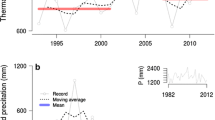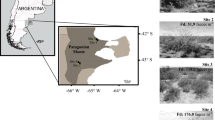Abstract
Herbivores shape plant communities through selective foraging. However, both herbivore selectivity and the plant’s ability to tolerate or resist herbivory may depend on the density of herbivores. In an alpine ecosystem with a long history of grazing, plants are expected to respond to both enhanced and reduced grazing pressures, and the interaction between plant traits and changes in species abundance are expected to differ between the two types of alteration of grazing regime. To understand the mechanisms behind species response, we investigated the relationship between sheep selectivity (measured in situ), plant traits and experimentally derived measures of change in species abundance as a response to the enhancement (from low to high density) or cessation (from low to zero density) of sheep grazing pressure over a six-year time period for 22 abundant herb species in an alpine habitat in south Norway. Sheep selected large, late-flowering herbs with a low leaf C/N ratio. Species that increased in abundance in response to enhanced grazing pressure were generally small and had high root/shoot ratios, thus exhibiting traits that reflect both resistance (through avoidance) and tolerance (through regrowth capacity) strategies. The abundance of selected species remained stable during the study period, and also under the enhanced grazing pressure treatment. There was, however, a tendency for selected species to respond positively to cessation of grazing, although overall responses to cessation of grazing were much less pronounced than responses to enhanced grazing. Avoidance through short stature (probably associated with increased light availability through the removal of tall competitors) as well as a certain amount of regrowth capacity appear to be the main mechanisms behind a positive response to enhanced grazing pressure in this study. The plant trait perspective clearly improves our insight into the mechanisms behind observed changes in species abundance when the disturbance regime is altered.


Similar content being viewed by others
References
Agrawal AA, Fishbein M (2006) Plant defense syndromes. Ecology 87:S132–S149
Albon SD, Langvatn R (1992) Plant phenology and the benefits of migration in a temperate ungulate. Oikos 65:502–513
Anderson VJ, Briske DD (1995) Herbivore-induced species replacement in grasslands—is it driven by herbivory tolerance or avoidance? Ecol Appl 5:1014–1024
Augustine DJ, McNaughton SJ (1998) Ungulate effects on the functional species composition of plant communities: herbivore selectivity and plant tolerance. J Wildl Manage 62:1165–1183
Austrheim G, Eriksson O (2001) Plant species diversity and grazing in the Scandinavian mountains—patterns and processes at different spatial scales. Ecography 24:683–695
Austrheim G, Evju M, Mysterud A (2005) Herb abundance and life-history traits in two contrasting alpine habitats in southern Norway. Plant Ecol 179:217–229
Austrheim G, Mysterud A, Pedersen B, Økland RH, Hassel K, Evju M (2008) Large scale experimental effects of three levels of sheep densities on an alpine ecosystem. Oikos 117:837–846
Billings WD (1974) Adaptations and origins of alpine plants. Arct Antarct Alp Res 6:129–142
Billings WD (1987) Constraints to plant growth, reproduction, and establishment in Arctic environments. Arct Antarct Alp Res 19:357–365
Bliss LC (1971) Arctic and alpine plant life cycles. Annu Rev Ecol Syst 2:405–438
Bowns JE, Bagley CF (1986) Vegetation responses to long-term sheep grazing on mountain-ranges. J Range Manage 39:431–434
Bråthen KA, Oksanen J (2001) Reindeer reduce biomass of preferred plant species. J Veg Sci 12:473–480
Bråthen K, Ims R, Yoccoz N, Fauchald P, Tveraa T, Hausner V (2007) Induced shift in ecosystem productivity? Extensive scale effects of abundant large herbivores. Ecosystems 10:773–789
Bullock JM (2000) Gaps and seedling colonization. In: Fenner M (ed) Seeds. The ecology of regeneration in plant communities, 2nd edn. CABI Publishing, Wallingford, pp 375–395
Bullock JM, Hill BC, Silvertown J, Sutton M (1995) Gap colonization as a source of grassland community change: effects of gap size and grazing on the rate and mode of colonization by different species. Oikos 72:273–282
Bullock JM, Franklin J, Stevenson MJ, Silvertown J, Coulson SJ, Gregory SJ, Tofts R (2001) A plant trait analysis of responses to grazing in a long-term experiment. J Appl Ecol 38:253–267
Choquenot D (1991) Density-dependent growth, body condition, and demography in feral donkeys: testing the food hypothesis. Ecology 72:805–813
Cingolani AM, Posse G, Collantes MB (2005) Plant functional traits, herbivore selectivity and response to sheep grazing in Patagonian steppe grasslands. J Appl Ecol 42:50–59
Coley PD, Bryant JP, Chapin FS (1985) Resource availability and plant antiherbivore defense. Science 230:895–899
Cornelissen JHC, Lavorel S, Garnier E, Díaz S, Buchmann N, Gurvich DE, Reich PB, ter Steege H, Morgan HD, van der Heijden MGA, Pausas JG, Poorter H (2003) A handbook of protocols for standardised and easy measurement of plant functional traits worldwide. Aust J Bot 51:335–380
de Bello F, Lepš J, Sebastiá M-T (2005) Predictive value of plant traits to grazing along a climatic gradient in the Mediterranean. J Appl Ecol 42:824–833
Demment MW, Van Soest PJ (1985) A nutritional explanation for body-size patterns of ruminant and nonruminant herbivores. Am Nat 125:641–672
Díaz A (2000) Can plant palatability trials be used to predict the effect of rabbit grazing on the flora of ex-arable land? Agric Ecosyst Environ 78:249–259
Díaz S, Noy-Meir I, Cabido M (2001) Can grazing response of herbaceous plants be predicted from simple vegetative traits? J Appl Ecol 38:497–508
Díaz S, Lavorel S, McIntyre S, Falczuk V, Casanoves F, Milchunas DG, Skarpe C, Rusch G, Sternberg M, Noy-Meir I, Landsberg J, Zhang W, Clark H, Campbell BD (2007) Plant trait responses to grazing—a global synthesis. Glob Chang Biol 13:313–341
Dodd M, Silvertown J, McConway K, Potts J, Crawley MJ (1995) Community stability: a 60-year record of trends and outbreaks in the occurrence of species in the Park Grass Experiment. J Ecol 83:277–285
Evju M, Mysterud A, Austrheim G, Økland RH (2006) Selecting herb species and traits as indicators of sheep grazing pressure in a Norwegian alpine habitat. Ecoscience 13:459–468
Garnier E (1992) Growth analyses of congeneric annual and perennial grass species. J Ecol 80:665–675
Grellmann D (2002) Plant responses to fertilization and exclusion of grazers on an arctic tundra heath. Oikos 98:190–204
Grime JP, Hillier SH (2000) The contribution of seedling regeneration to the structure and dynamics of plant communities, ecosystems and larger units of the landscape. In: Fenner M (ed) Seeds. The ecology of regeneration in plant communities, 2nd edn. CABI Publishing, Wallingford, pp 361–374
Hæggström C-A (1990) The influence of sheep and cattle grazing on wooded meadows in Åland, SW Finland. Acta Bot Fenn 141:1–28
Hebblewhite M, Merril E, McDermid G (2008) A multi-scale test of the forage maturation hypothesis in a partially migratory ungulate population. Ecol Monogr 78:141–166
Hellström K, Huhta A-P, Rautio P, Tuomi J, Oksanen J, Laine K (2003) Use of sheep grazing in the restoration of semi-natural meadows in northern Finland. Appl Veg Sci 6:45–52
Hester AJ, Bergman M, Iason GR, Moen J (2006) Impacts of large herbivores on plant community structure and dynamics. In: Danell K, Bergstrom R, Duncan P, Pastor J (eds) Large herbivore ecology, ecosystem dynamics and conservation. Cambridge University Press, Cambridge, pp 97–141
Holechek JL, Gomez H, Molinar F, Galt D (1999) Grazing studies: what we’ve learned. Rangelands 21:12–16
Jónsdottir IS (1991) Effects of grazing on tiller size and population dynamics in a clonal sedge (Carex bigelowii). Oikos 62:177–188
Kausrud K, Mysterud A, Rekdal Y, Holand Ø, Austrheim G (2006) Density dependence in foraging behaviour of sheep on alpine pastures: effects of scale. J Zool 270:63–71
Lavorel S, McIntyre S, Landsberg J, Forbes TDA (1997) Plant functional classifications: from general groups to specific groups based on response to disturbance. Trends Ecol Evol 12:474–478
Lennartsson T (1997) Demography, reproductive biology and adaptive traits in Gentianella campestris and G. amarella: evaluating grassland management for conservation by using indicator plant species. Ph.D. thesis, Swedish University of Agricultural Sciences, Uppsala
Lennartsson T, Tuomi J, Nilsson P (1997) Evidence for an evolutionary history of overcompensation in the grassland biennial Gentianella campestris (Gentianaceae). Am Nat 149:1147–1155
Lid J, Lid DT (2005) Norsk flora, 7th edn. Det Norske Samlaget, Oslo
Louault F, Pillar VD, Aufrère J, Garnier E, Soussana J-F (2005) Plant traits and functional types in response to reduced disturbance in a semi-natural grassland. J Veg Sci 16:151–160
McIntyre S, Lavorel S, Landsberg J, Forbes TDA (1999) Disturbance response in vegetation—towards a global perspective on functional traits. J Veg Sci 10:621–630
Milchunas DG, Lauenroth WK (1993) Quantitative effects of grazing on vegetation and soils over a global range of environments. Ecol Monogr 63:327–366
Milchunas DG, Sala OE, Lauenroth WK (1988) A generalized model of the effects of grazing by large herbivores on grassland community structure. Am Nat 132:87–106
Mobæk R, Mysterud A, Loe LE, Holand Ø, Austrheim G (2009) Density dependent and temporal variability in habitat selection by a large herbivore: an experimental approach. Oikos 118:209–218
Molau U, Nordenhäll U, Eriksen B (2005) Onset of flowering and climate variability in an alpine landscape: a 10-year study from Swedish Lapland. Am J Bot 92:422–431
Mulder CPH (1999) Vertebrate herbivores and plants in the Arctic and subarctic: effects on individuals, populations, communities and ecosystems. Perspect Plant Ecol Evol Syst 2:29–55
Mysterud A, Mysterud I (1999) Bærekraftig bruk og forvaltning av Setesdals Vesthei og Ryfylkeheiene. En utredning med spesiell vekt på økologiske effekter av husdyrbeiting i utmark. Biological Institute, University of Oslo
Oksanen L, Ranta E (1992) Plant strategies along mountain vegetation gradients: a test of two theories. J Veg Sci 3:175–186
Olofsson J (2006) Short- and long-term effects of changes in reindeer grazing pressure on tundra heath vegetation. J Ecol 94:431–440
Pakeman RJ (2004) Consistency of plant species and trait responses to grazing along a productivity gradient: a multi-site analysis. J Ecol 92:893–905
Pérez-Harguindeguy N, Díaz S, Vendramini F, Cornelissen JHC, Gurvich DE, Cabido M (2003) Leaf traits and herbivore selection in the field and in cafeteria experiments. Aust Ecol 28:642–650
Rekdal Y (2001) Vegetation and forage at Minnestølen (NIJOS document 23(01)). Norwegian Institute of Land Inventory (NIJOS), Ås, pp 1–21
Senft RL, Coughenour MB, Bailey DW, Rittenhouse LR, Sala OE, Swift DM (1987) Large herbivore foraging and ecological hierarchies. Bioscience 37:789–799
Sigmond E (1998) Odda map of rock; Odda; 1:250 000. Norwegian Geological Surveys, Trondheim
Steen H, Mysterud A, Austrheim G (2005) Sheep grazing and rodent populations: evidence of negative interactions from a landscape scale experiment. Oecologia 143:357–364
Strauss SY, Agrawal AA (1999) The ecology and evolution of plant tolerance to herbivory. Trends Ecol Evol 14:179–185
R Development Core Team (2008) R: a language and environment for statistical computing. R Foundation for Statistical Computing, Vienna
Vandvik V (2004) Gap dynamics in perennial subalpine grasslands: trends and processes change during secondary succession. J Ecol 92:86–96
Vesk PA, Westoby M (2001) Predicting plant species’ responses to grazing. J Appl Ecol 38:897–909
Villalba JJ, Provenza FD (1999) Effects of food structure and nutritional quality and animal nutritional state on intake behaviour and food preferences of sheep. Appl Anim Behav Sci 63:145–163
Weiher E, van der Werf A, Thompson K, Roderick M, Garnier E, Eriksson O (1999) Challenging theophrastus: a common core list of plant traits for functional ecology. J Veg Sci 10:609–620
Westoby M (1999) The LHS strategy scheme in relation to grazing and fire. In: Eldridge D, Freudenberger D (eds) VI International Rangeland Congress, vol 2. International Rangeland Congress, Townsville, pp 893–896
Acknowledgments
This study was funded by the Research Council of Norway (Project 153601/432, 134361/720 and 165846/S30). The authors wish to thank Rune Moe for assistance with field work and two anonymous referees for valuable comments on an earlier draft of the manuscript. The sheep grazing experiment complies with the laws of Norway.
Author information
Authors and Affiliations
Corresponding author
Additional information
Communicated by Jon Keeley.
Electronic supplementary material
Below is the link to the electronic supplementary material.
Rights and permissions
About this article
Cite this article
Evju, M., Austrheim, G., Halvorsen, R. et al. Grazing responses in herbs in relation to herbivore selectivity and plant traits in an alpine ecosystem. Oecologia 161, 77–85 (2009). https://doi.org/10.1007/s00442-009-1358-1
Received:
Accepted:
Published:
Issue Date:
DOI: https://doi.org/10.1007/s00442-009-1358-1




